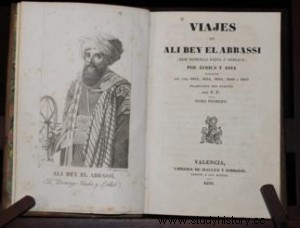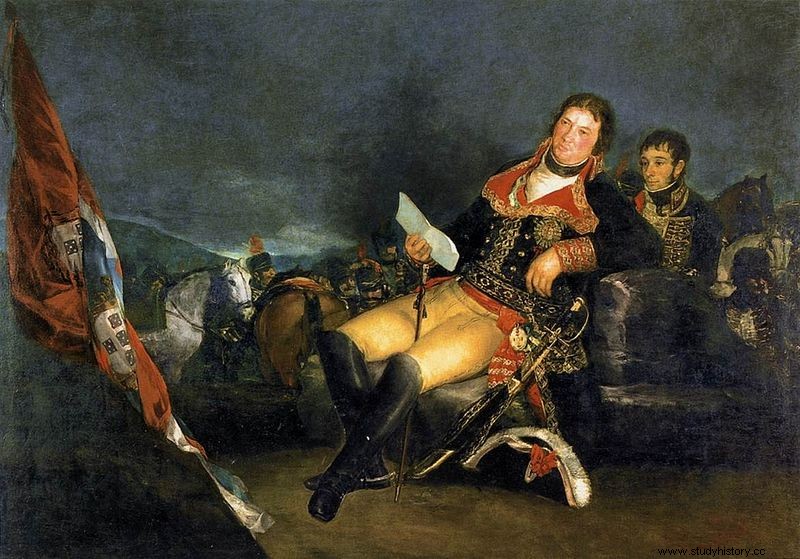In December 1788 he was crowned King of Spain Carlos IV , a monarch without character or personality – he left the government in the hands of others like his wife María Luisa de Parma or the valid Manuel Godoy – and who was overcome by the events of the time –French Revolution -. A conversation with his father, Carlos III, being crown prince is a true reflection of his weak personality, even his naivete...
We kings are the only ones who can rest assured that our wives are not cheating on us. Where are they going to find something better than a prince?
His father replied:
But what a fool you are my son!

Charles IV
Already as king, he left government issues in the hands of the worthy Manuel Godoy and some say that he also took his place in the royal bed. Across the Strait of Gibraltar, Muley Suleiman , of the Alaouite dynasty, was proclaimed Sultan of Morocco. In 1799, Carlos IV and Muley Suleiman signed the Treaty of Peace, Friendship, Navigation, Commerce and Fishing that, initially, they showed a predisposition to understanding and diplomacy but that repeatedly would remain a dead letter. [As a curiosity:In 1799, Morocco was the first country to recognize the United States and the first American embassy in the world ] In 1801, due to the scarcity of the harvests and as had been done before, the Spanish government began the procedures to buy wheat from Morocco. Given the refusal of Sultan Suleiman, Godoy ordered the Spanish ambassador to offer Ceuta and Melilla as currency for the coveted wheat. The sultan refused… he would seize the Spanish possessions by force. The occupation of Morocco passed through Manuel Godoy's head and thus to have his own granary in North Africa -in the same way that it was for the Roman Empire-.

Manuel Godoy
Like a glove, that same year Domingo Badía and Leblich presented to the government a project called Trip plan to Africa :Pretending to be a Muslim of Syrian origin, he would travel through Africa studying the commercial possibilities and drawing up maps. That scientific project of Domingo Badía, for Godoy became an opportunity to explore the territory of Morocco and learn about its forces, approach the enemy tribes of the sultan for a possible alliance in the event of a war conflict... turn Africa into a cheaper and safer alternative than America in the supply of precious metals and raw materials . Despite the institutional refusal to finance the project, Godoy himself decided to authorize it and ordered the financing. And as a good secret Spanish project –typical of the agents Mortadelo and Filemón – On November 28, 1801 the trip was published in the Diario de Madrid (luckily the sultan was not subscribed to the newspaper).

Ali Bey
In order not to be discovered, he circumcised himself, perfected his Arabic, procured suitable clothing and the name of Ali Bey al-Abbasi with a complete genealogy that made him a descendant of the Prophet himself. In 1803 he began his journey in Tangier. Thanks to his genealogy and the many presents he handed out along the way, he got an audience with Sultan Soleiman. From this he obtained a safe-conduct to travel throughout his kingdom. For two years he was traveling through that territory as close as it was unknown, knowing the customs of its people and even contacting the sultan's enemies for a possible insurrection. The reports reached Godoy through Francisco Amorós , Spanish consul in Mogador (today Essaouira ) -strategic commercial port-. In 1804, a report by Ali Bey advised sending troops and weapons to Ceuta to support an insurrection that was brewing. Godoy began all the preparations... but when Carlos IV found out, he forbade the shipment. So many movements raised suspicions and in 1805 the sultan ordered Ali Bey to leave Morocco.
At that time his political journey ended and his scientific journey began, which took him to visit Libya, Algeria, Egypt, Mecca -where he visited the Kaaba, a place forbidden to non-Muslims-, Jerusalem, Syria and Constantinople, where he learned of the entry of the Napoleonic armies in Spain. After a 5-year journey, on July 12, 1808, he returned home. When he arrives he finds himself in a troubled Spain under the puppet government of Joseph Bonaparte. Either because he was Frenchified or because he was following the orders of Carlos IV, with whom he coincided in Bayonne, the fact is that Domingo stayed in Spain and in 1809 he was appointed mayor of Segovia and the following year of Córdoba, where he would be responsible for the construction of three cemeteries, the inauguration of the Gardens of Agriculture and the layout of the first plane of Córdoba. The permanent municipal garbage collection service and other municipal provisions to keep the city clean are also due to him, such as the obligation of the neighbors to sweep and water the sidewalks of the houses twice a day or to bury the dead animals far from the town. urban and at a certain depth. After the French defeat he went into exile in Paris where in July 1814 his book «Ali Bey el Abbassi's Travels through Africa and Asia during the years 1803, 1804, 1805, 1806 and 1807 was published. «; a work in three volumes accompanied by a fourth with maps of his journey. A masterpiece of travel literature.

Ali Bey's true identity was kept secret until 1836, when the first Spanish translation of his work was published. In his prologue, it is indicated that this Syrian traveler was actually Domingo Badía and includes a brief biography of his life. That same year, Manuel Godoy published the Memoirs of him and in them he reveals that Badía was a secret agent in his service. Domingo died in 1818 in Damascus on a trip to the service of France -it is believed that he could have been poisoned when discovered by the English-.
Sources:The Metamorphosis of Ali Bey, Secret Explorations in Africa (Nowtilus) – Fernando Ballano
